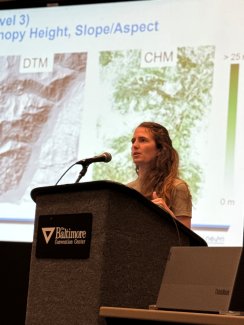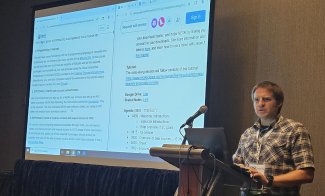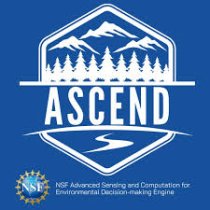Featured Experts: Bridget Hass and Eric Sokol on NEON’s Impact at ESA 2025
August 28, 2025
In today’s world, the abundance of data that exists can be a springboard for scientific breakthroughs in ecology – but only when utilized effectively. It can be challenging to process the entirety of data sets and understand the most effective ways to optimally work with that data. Collaboration can be an effective tool when it comes to interpreting data, and NEON helps bridge that gap.
At the 2025 Ecological Society of America (ESA) Annual Meeting in August, NEON made its presence felt, not just as a data provider, but as a convener and enabler of ecological progress. This year’s theme, Ecology is Everywhere, reinforced a growing expectation that science must meet the moment through building partnerships that drive real-world impact.
The Power of Partnership
With over 15 presentations, exhibits and workshops supported by NEON staff, the impact of NEON’s data and expertise was evident across the conference.
To shed light on the importance of bringing minds in ecology together, NEON’s Bridget Hass, Remote Sensing Data Scientist and Eric Sokol, PhD, Senior Quantitative Ecologist, shared their perspectives on the vital role data collection plays in innovative advancements. They were able to connect with ecologists of varying years of expertise to learn how they utilize NEON’s expansive data sets.
During the event, Hass excitedly noted, “ecology really is everywhere, and there’s an abundance of interconnectedness between various projects. Being at the conference and talking to other ecologists, seeing what they’re working on, gives you that bigger perspective to help enhance your own research.”

Data’s Crucial Role in Scientific Advancement
As the world rapidly evolves, given the artificial intelligence (AI) boom and other advances, access to trustworthy, free and open data is more critical than ever. Sokol and Hass highlighted ways ecologists can leverage data synthesis to deepen understanding and improve ecological research outcomes.
Sokol and his team collaborated with ecologists to identify opportunities and barriers for NEON’s data. “We’re in a unique position to help ecologists synthesize data to answer questions that couldn’t be answered before,” he explained, stressing that “AI in ecology is only as good as the data we provide it with.” Sokol teamed up with data scientists from the Long Term Ecological Research (LTER) network and the Environmental Data Initiative (EDI) to teach short courses to help attendees understand the importance of developing standards and best practices in ecological synthesis. They taught how to use tools like the ecocomDP R package to access and work with continental scale biodiversity data as well.
He also taught an introduction to ecological forecasting workshop, designed in collaboration with researchers from the Ecological Forecasting Initiative (EFI). The focus of the workshop was to predict trends in ground beetle populations, which are bioindicator taxa collected by NEON.
Another standout moment was Hass’ workshop on how NEON is leveraging Google Earth Engine (GEE) to expand the use of NEON remote sensing data to the larger remote sensing community. Hass has seen “a data revolution in the last 10 years, with the amount of data that’s being generated and available to use.” The GEE platform is a powerful tool that helps the community work with these large amounts of data in a cloud computing environment.
She also collaborated with NASA in joint training for ESA attendees on airborne and field datasets, emphasizing the need for NEON’s field data to help train and inform airborne data AI models. Given the successful collaboration between NEON and NASA, Hass and her team hope to continue these training offerings to broaden the use of NEON's remote sensing data.

Collaboration is at the Core of Ecology
During ESA 2025, it was clear that NEON represents how sustained, open science infrastructure can equip researchers, educators and decision-makers with the tools needed to respond to change.
Whether helping an ecologist predict droughts through beetle forecasting, a graduate student exploring climate-vegetation interactions, or an instructor introducing real-world datasets into coursework, NEON continues to be a resource that not only supports science but also strengthens the ecological community it serves.
NEON has enabled hundreds of scientists to come together and apply long-term ecological data to pressing research questions and environmental challenges. Learn more about NEON’s pivotal role in bridging the gap of data collection and ecological expertise here.

